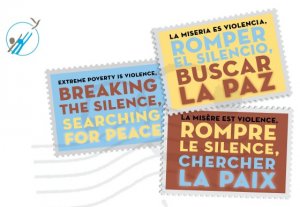Speech by Donald Lee, United Nations Department of Economic and Social Affairs.

Extreme poverty eradication projects ill-adapted to people’s needs. International Colloquium “Extreme poverty is Violence. Breaking the Silence. Searching for Peace” 26 January – Public event at UNESCO House
Extreme poverty does not entail just having unsatisfied material needs or being undernourished. It is often accompanied by a degrading state of powerlessness. Even in democratic and relatively well-governed countries, poor people have to accept daily humiliations without protest. Often, they cannot provide for their children and have a strong sense of shame and failure. When they are trapped in poverty, the poor lose hope of ever escaping from their hard work for which they often have nothing to show beyond bare survival.
Despite, the strenuous past and on-going efforts of the United Nations to reduce poverty there is still a large gap between desired outcomes and actual progress that is unlikely to be bridged anytime soon. The fact is many countries will not achieve most of the MDGs by 2015. Furthermore, the worsening global economic situation is also threatening the gains that have been achieved so far.
Why is this happening? One of the reasons for this is under-funding or insufficient resources. Another reason is the lack of local capacity to deliver poverty reduction programmes – programmes to provide food assistance, for example, will not work well if there are insufficient trained personnel or the administrative infrastructure to implement the programmes. Yet another is the poverty eradication programmes or projects are inefficient or ineffective because they are not designed to meet the needs of the people they are designed to reach.
In view of the limited time available I shall only raise some key issues for our discussion about how to ensure poverty eradication programmes better meet the needs of people living in extreme poverty.
Shortfall of development assistance
The New Economics Foundation reports that for every $100 of economic growth between 1990 and 2001, only $0.60 went toward poverty reduction for those on less than $1 a day. There is a very real danger that poverty reduction efforts around the world will suffer as major aid donor countries face severe budget cuts as a result of the continuing global economic crisis. Such under-funding of poverty eradication programmes not only fail to address the needs of people living in poverty but also sow the seeds for poverty that will persist over succeeding generations.
Participatory not paternalistic approaches
The early poverty reduction programmes tended to be highly paternalistic in the sense that they prescribed programmes or course of action, often without consultation with the affected population about their needs. You see this approach clearly in the early rural and urban poverty programmes, for example, that were contained in five-year development plans. As you can imagine, since there was no consultation, these plans were often imposed upon poor people without due consideration to their needs, cultures and values. Also assistance that is provided conditional on conformity with certain behaviour, such as working on public infrastructure projects, does not meet the needs of people living in extreme poverty.
We now recognize that participatory approaches which promote consultation and voice actually enhance the efficiency and effectiveness of poverty reduction programmes by empowering people to be part of the process to decide on matters that directly affect their lives. Participation is one of the cornerstones of the approach to development contained in the Millennium Declaration adopted by the United Nations in 2000.
Adopt Best Practices
A best practice is a method or technique that has consistently shown results superior to those achieved with other means, and that is used as a benchmark. The sharing and adoption of best practices can ensure that poverty eradication projects better meet the needs of people living in extreme poverty. However, the adoption of best practices needs to be moderated by attention to the particular context and special needs of people living in different countries or even in different parts of the same country.
Let me share with you an example of a best practice called the Millennium Villages Project.
There are currently 80 Millennium Villages in 10 African countries which fight poverty at the village level through community-led development. These projects which offer simple solutions like providing high-yield seeds, fertilizers, medicines, drinking wells, and materials to build school rooms and clinics are effectively combating extreme poverty and nourishing communities into a new age of health and opportunity.
The Millennium Villages Project demonstrates how effective poverty eradication programmes can be when we work in partnership with poor people to ensure that they can live and work in sustainable economic and social environments.

